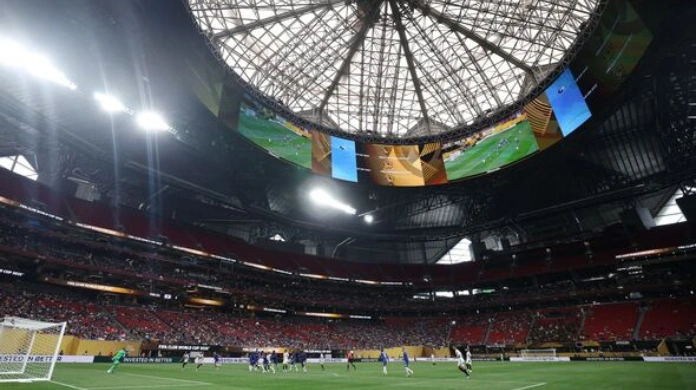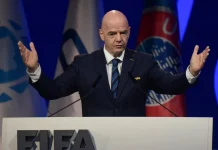FIFA’s 2025 Club World Cup was sold to the world as a groundbreaking football extravaganza—a 32-team tournament designed to revolutionize the sport’s global appeal. But behind the glossy marketing campaigns and star-studded promos lies a harsh reality: vast stadiums half-empty, fans disillusioned, and a tournament struggling to justify its existence. The so-called “global spectacle” has instead exposed FIFA’s reckless prioritization of commercial interests over genuine fan engagement and sporting integrity.
Scheduling for TV Ratings, Not Fans
The core of the problem is FIFA’s cynical scheduling strategy. Matches are deliberately slotted to capture prime-time European TV audiences, ignoring the fact that the tournament is physically staged in the United States. This means weekday afternoon kickoffs when local fans are at work or school, effectively shutting out the very people who should be the tournament’s lifeblood.
One Atlanta fan bitterly remarked,
“FIFA clearly doesn’t care about American fans. They want us to watch on TV but not actually show up.”
This deliberate sidelining of local supporters reveals a governing body more obsessed with broadcast dollars than the experience of fans or players.
Ticket Pricing: A Greedy Barrier to Attendance
FIFA’s initial ticket pricing strategy was another glaring misstep. Premium prices for a tournament with little local resonance alienated casual fans and families. Only after ticket sales flopped did FIFA scramble to slash prices, offering desperate last-minute discounts and giveaways.
A Miami supporter lamented,
“They priced out real fans, then tried to bribe us with cheap tickets at the last minute. It felt like a cash grab, not a celebration of football.”
This approach not only damaged fan trust but underscored FIFA’s prioritization of profit over accessibility.
Local Disinterest Exposed: Football’s Fragile US Footing
Despite FIFA’s grand ambitions, football remains a niche sport in much of the US, overshadowed by entrenched American sports. The Club World Cup’s failure to capture widespread local interest exposes FIFA’s arrogance in assuming that star players and big names alone can fill stadiums.
A Seattle fan’s blunt assessment sums it up:
“This tournament means nothing to most Americans. FIFA’s hype machine can’t mask that.”
The disconnect between FIFA’s global vision and local reality has left the tournament stranded—big on paper, empty in practice.
The Scorching Heat: A Convenient Excuse or Genuine Hazard?
FIFA has pointed to extreme heat as a factor deterring attendance, but critics argue this is a convenient excuse for poor planning. Scheduling high-profile matches in the sweltering midday sun, especially in southern cities, was a foreseeable problem that FIFA chose to ignore.
One fan at the Miami match said,
“They knew it would be hot. They didn’t care. It’s like they set us up to fail.”
The heat has become a symbol of FIFA’s disregard for fan comfort and safety in pursuit of TV ratings.
FIFA’s Spin Machine: Denial and Deflection
Faced with mounting criticism, FIFA has resorted to spin and selective transparency. President Gianni Infantino’s insistence that the tournament is a “resounding success” rings hollow against the backdrop of empty seats and fan frustration.
FIFA’s reluctance to release detailed attendance figures for all matches fuels suspicion that the governing body is trying to hide the scale of the failure. This lack of accountability only deepens the credibility crisis.
Voices from the Field: Players and Coaches Speak Out
Even players and coaches have voiced discomfort with the tournament’s atmosphere. Chelsea manager Mauricio Pochettino admitted, “Playing in a half-empty stadium is demoralizing. The energy just isn’t there.” Such candid remarks from high-profile figures highlight how the empty seats undermine not only fan experience but also player performance.
What FIFA Really Prioritizes: Profit Over Passion
At its core, the Club World Cup’s attendance fiasco reveals FIFA’s true priorities: maximizing broadcast revenue and sponsorship deals at the expense of the sport’s soul. The tournament’s scheduling, pricing, and marketing strategies all point to a governing body that values money over meaningful fan connection.
This commercial obsession risks alienating the very supporters who sustain football’s global popularity. The Club World Cup’s empty seats are a visible symptom of a deeper malaise within FIFA’s leadership.
The Ugly Truth: A Tournament in Crisis
The 2025 Club World Cup is not just a logistical failure—it is a crisis of vision and values. FIFA’s grand promises have crumbled under the weight of poor planning, commercial greed, and disregard for fans. The result is a tournament that looks impressive on paper but feels hollow in the stands.
As one fan put it,
“FIFA hyped this as the future of football, but all they delivered was empty seats and broken trust.”
Time for FIFA to Face the Music
FIFA can no longer hide behind marketing slogans and selective statistics. The Club World Cup’s attendance disaster demands honest reflection and radical change. If FIFA wants to reclaim credibility, it must put fans before profits, respect local realities, and stop treating football as just another commodity.
Until then, the Club World Cup will remain a cautionary tale of how hype without substance leads only to empty seats—and an empty legacy.












